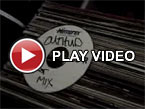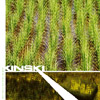 For those who are familiar only with the most easily available recordedworks of Kinski (ie: the Sub Pop releases), this album might besomewhat of a mystery: it's not the blistering loud rock sounds feltmiles away, but a collection of the gentle, spacey tunes Kinski liveaudiences have paid witness to for years. The disc opens with the briefechoed guitar work of "Never Compete with Small Girls," then isfollowed by a nearly half hour live performance, "The Misprint in theGutenberg Print Shop," recorded live in Seattle. This tune, along withthe rest of the disc pretty much, is a real trip, with twitteringprimitive effects and chiming sounds, rumbling echoed bass, and aserene flute on top. It's ghostly and intoxicating, moves through anumber of different phases, from swelling sounds to parts so quiet apin could be heard dropping, and it never gets stale or dull. I'm notsurprised the group has toured extensively with Acid Mothers Temple,but unlike AMT, Kinski has never bored me or made me long for a songending. There's not much room left on the disc after the massive trackbut three tracks under five minutes complete the collection. "Crepesthe Cheap" continues with drumless bliss like a spaceship in a cheapsci-fi film taking off, while "Bulky Knit Cheerleader Sweater" is awafting wall of guitars as dense as the title, and the closer, "There'sNothing Sexy About Time" drones off into the distance. While Don't Climbisn't representative of Kinski's entire range of sound, it does providea good companion piece to the more rockin bits and can certainlyprovide a good "coming down" album when leaving a concert from thefoursome that has left ears bleeding in the path.
For those who are familiar only with the most easily available recordedworks of Kinski (ie: the Sub Pop releases), this album might besomewhat of a mystery: it's not the blistering loud rock sounds feltmiles away, but a collection of the gentle, spacey tunes Kinski liveaudiences have paid witness to for years. The disc opens with the briefechoed guitar work of "Never Compete with Small Girls," then isfollowed by a nearly half hour live performance, "The Misprint in theGutenberg Print Shop," recorded live in Seattle. This tune, along withthe rest of the disc pretty much, is a real trip, with twitteringprimitive effects and chiming sounds, rumbling echoed bass, and aserene flute on top. It's ghostly and intoxicating, moves through anumber of different phases, from swelling sounds to parts so quiet apin could be heard dropping, and it never gets stale or dull. I'm notsurprised the group has toured extensively with Acid Mothers Temple,but unlike AMT, Kinski has never bored me or made me long for a songending. There's not much room left on the disc after the massive trackbut three tracks under five minutes complete the collection. "Crepesthe Cheap" continues with drumless bliss like a spaceship in a cheapsci-fi film taking off, while "Bulky Knit Cheerleader Sweater" is awafting wall of guitars as dense as the title, and the closer, "There'sNothing Sexy About Time" drones off into the distance. While Don't Climbisn't representative of Kinski's entire range of sound, it does providea good companion piece to the more rockin bits and can certainlyprovide a good "coming down" album when leaving a concert from thefoursome that has left ears bleeding in the path.  For those who are familiar only with the most easily available recordedworks of Kinski (ie: the Sub Pop releases), this album might besomewhat of a mystery: it's not the blistering loud rock sounds feltmiles away, but a collection of the gentle, spacey tunes Kinski liveaudiences have paid witness to for years. The disc opens with the briefechoed guitar work of "Never Compete with Small Girls," then isfollowed by a nearly half hour live performance, "The Misprint in theGutenberg Print Shop," recorded live in Seattle. This tune, along withthe rest of the disc pretty much, is a real trip, with twitteringprimitive effects and chiming sounds, rumbling echoed bass, and aserene flute on top. It's ghostly and intoxicating, moves through anumber of different phases, from swelling sounds to parts so quiet apin could be heard dropping, and it never gets stale or dull. I'm notsurprised the group has toured extensively with Acid Mothers Temple,but unlike AMT, Kinski has never bored me or made me long for a songending. There's not much room left on the disc after the massive trackbut three tracks under five minutes complete the collection. "Crepesthe Cheap" continues with drumless bliss like a spaceship in a cheapsci-fi film taking off, while "Bulky Knit Cheerleader Sweater" is awafting wall of guitars as dense as the title, and the closer, "There'sNothing Sexy About Time" drones off into the distance. While Don't Climbisn't representative of Kinski's entire range of sound, it does providea good companion piece to the more rockin bits and can certainlyprovide a good "coming down" album when leaving a concert from thefoursome that has left ears bleeding in the path.
For those who are familiar only with the most easily available recordedworks of Kinski (ie: the Sub Pop releases), this album might besomewhat of a mystery: it's not the blistering loud rock sounds feltmiles away, but a collection of the gentle, spacey tunes Kinski liveaudiences have paid witness to for years. The disc opens with the briefechoed guitar work of "Never Compete with Small Girls," then isfollowed by a nearly half hour live performance, "The Misprint in theGutenberg Print Shop," recorded live in Seattle. This tune, along withthe rest of the disc pretty much, is a real trip, with twitteringprimitive effects and chiming sounds, rumbling echoed bass, and aserene flute on top. It's ghostly and intoxicating, moves through anumber of different phases, from swelling sounds to parts so quiet apin could be heard dropping, and it never gets stale or dull. I'm notsurprised the group has toured extensively with Acid Mothers Temple,but unlike AMT, Kinski has never bored me or made me long for a songending. There's not much room left on the disc after the massive trackbut three tracks under five minutes complete the collection. "Crepesthe Cheap" continues with drumless bliss like a spaceship in a cheapsci-fi film taking off, while "Bulky Knit Cheerleader Sweater" is awafting wall of guitars as dense as the title, and the closer, "There'sNothing Sexy About Time" drones off into the distance. While Don't Climbisn't representative of Kinski's entire range of sound, it does providea good companion piece to the more rockin bits and can certainlyprovide a good "coming down" album when leaving a concert from thefoursome that has left ears bleeding in the path. 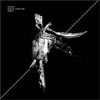 Digital Lifeforms marks the point where Richard H. Kirk, formerly a dour, paranoid composer, released a happy, intelligent, danceable album. Originally released on Touch in 1993, the disc consists of ten distinct, separate, non-experimental tracks, all upbeat and surprisingly commercial (although without sounding naive, obvious or shit). For those who weren't able to get the original copy twelve years ago, this expanded version is now available.
Digital Lifeforms marks the point where Richard H. Kirk, formerly a dour, paranoid composer, released a happy, intelligent, danceable album. Originally released on Touch in 1993, the disc consists of ten distinct, separate, non-experimental tracks, all upbeat and surprisingly commercial (although without sounding naive, obvious or shit). For those who weren't able to get the original copy twelve years ago, this expanded version is now available.
Embarassingly enough, I didn't discover Biting Tongues until recently:I had been just flipping through some old vinyl at the radio stationand happened upon some old Factory 12" singles by Biting Tongues andwas drawn by the comments on the sleeves. The CompressorEP soon became a frequent spin on the radio show. As an 808 State fan,it was even more embarassing to admit that I hadn't been aware of thisgroup, as it featured Graham Massey through their entire existencebetween 1979 through 1989. LTM has taken the initiative, as they havewith a number of old Factory groups, to reintroduce their music to thepublic. What works on these reissues is the music: it's all enjoyableand the songs are also valuble in understanding some of the good thingsthat laid groundwork for much of the DFA and Output rosters and thestyles that bridged a time in Manchester's musical history after thepunk and Joy Division heyday and before the sound of acid and 808State's heyday. What I don't like (and of course, I'm being nitpicky asalways) is the lack of original artwork included in the booklets andthe terrible font choices inside, but that's only very minor. For fulldiscography along with images and other visuals, bitingtongues.comis a great resource. Coincidentally, the original four-piece BitingTongues are scheduled to perform this coming week at the ICA in Londonalong with their old touring partners/space sharers Crispy Ambulance.(Check the listings because the event's listed as Thursday, May 29thand Thursday is not the 29th.)
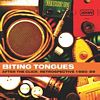 After the Click: Retrospective 1980-89 is the first in theseries and serves as a perfect introduction. It features 16 songshand-picked by Graham Massey, himself, and comes with a discography,interview, and liner notes for each track included. What appeals to memost about their sound and a other appealing contemporaries like 23Skidoo, A Certain Ratio, James Chance, and Liquid Liquid is the looseattitude, vibrant energy, tight rhythm section, and a sparsearrangement that doesn't cloud the sound with too much junk. Low,brooding vocals (most frequently provided by Ken Hollings, author of Destroy All Monsters and frequent contributor to The Wire magazine) are common to the early tracks, lifted off the Don't Heal LP, originally released on Situation Two in 1981. "Denture Beach" is the only track from the Live Itcassette, and is fantastically soulful for a primitive recording:completely instrumental, with a hypnotic bassline, 808 drum machinewith real drums and a blistering saxophone. My only complaint is thefadeout: for all I know, these guys could have gone on for an hour (andI wouldn't have minded). For the rest of the earlier 1980s materialincluded, the group switch up arrangements with staccato, unmelodicvocals, no bass or guitar, but numerous claps and extranous tapes on"Dirt for 485," chugging bass with tape f/x and layered screaming saxsolos on "Iyabhoone," and "44," with a spooky spoken story. Tasty noisytape experiments like 1983's "Feverhouse part 1," from the Feverhouse Soundtrackappear, but it's not even remotely common to the other beat heftymildly jazz-influenced songs. Other highlights include the immaculate"Compressor" and a live recording of "Everywhere But Here," neverrecorded in the studio. By the end of the collection, and their career,the group was down to a duo of Graham Massey and saxophonist HowardWalmsley. Massey was playing more with drum machines and programmedmelodies, trying to fill in the gaps left by the departures of othermembers. While it was a formula that translated well to 808 State, inthe Biting Tongues setting, things didn't sound quite right. "DoubleGold St. Paul" was recorded for the album Recharge and itsounds like a somewhat uncomfortable and clumsy demo for the early1990s incarnation of 808 State. It was clearly time for the BitingTongues to end.
After the Click: Retrospective 1980-89 is the first in theseries and serves as a perfect introduction. It features 16 songshand-picked by Graham Massey, himself, and comes with a discography,interview, and liner notes for each track included. What appeals to memost about their sound and a other appealing contemporaries like 23Skidoo, A Certain Ratio, James Chance, and Liquid Liquid is the looseattitude, vibrant energy, tight rhythm section, and a sparsearrangement that doesn't cloud the sound with too much junk. Low,brooding vocals (most frequently provided by Ken Hollings, author of Destroy All Monsters and frequent contributor to The Wire magazine) are common to the early tracks, lifted off the Don't Heal LP, originally released on Situation Two in 1981. "Denture Beach" is the only track from the Live Itcassette, and is fantastically soulful for a primitive recording:completely instrumental, with a hypnotic bassline, 808 drum machinewith real drums and a blistering saxophone. My only complaint is thefadeout: for all I know, these guys could have gone on for an hour (andI wouldn't have minded). For the rest of the earlier 1980s materialincluded, the group switch up arrangements with staccato, unmelodicvocals, no bass or guitar, but numerous claps and extranous tapes on"Dirt for 485," chugging bass with tape f/x and layered screaming saxsolos on "Iyabhoone," and "44," with a spooky spoken story. Tasty noisytape experiments like 1983's "Feverhouse part 1," from the Feverhouse Soundtrackappear, but it's not even remotely common to the other beat heftymildly jazz-influenced songs. Other highlights include the immaculate"Compressor" and a live recording of "Everywhere But Here," neverrecorded in the studio. By the end of the collection, and their career,the group was down to a duo of Graham Massey and saxophonist HowardWalmsley. Massey was playing more with drum machines and programmedmelodies, trying to fill in the gaps left by the departures of othermembers. While it was a formula that translated well to 808 State, inthe Biting Tongues setting, things didn't sound quite right. "DoubleGold St. Paul" was recorded for the album Recharge and itsounds like a somewhat uncomfortable and clumsy demo for the early1990s incarnation of 808 State. It was clearly time for the BitingTongues to end.
 For those primarily interested in the Factory Records label output, Compressed conveniently collects only the recordings released by Factory of Biting Tongues. Included are the Trouble Hand and Compressor releases in their entirety along with the complete soundtrack to Feverhouse,a black and white 16mm film by fellow Tongues Ken Hollings and HowardWalmsley. It was the film in its rough form that interested Factory'sTony Wilson to do a parallel release of the soundtrack and the film onthe new video extension of the Factory label, Ikon. The ten track LPwas released in 1985 along with the movie, gaining praise from a numberof press folks and showing in a couple rare locations. All ten tracksappear (at the end of this disc however) and they sound like thesoundtrack to an "atmospheric" art film a group of rhythmic tapeexperimenting rock musicians would make. Muffled horn sounds and tapenoise, instrumental subdued rhythmic numbers, field recordings putthrough effects, and droning tape manipulations are common. Theremastering job is nice as I can only begin to imagine how annoyingcrackly vinyl could easily ruin these more quiet recordings. Trouble Handwas the second Factory release: a five-track 12" EP featuring thespeedy vocal title track and the equally speedy "Panorama," which has anoisy opening (it sounds like somebody drumming inside the hull of asubmarine) and deftly slips right in to a fierce flanging bassline.Things slow down for the jazzy horn-saturated "Meat Mask Separatist,"but pick back up again for "Boss Toyota Trouble." Compressor isprobably the most celebrated peak of Biting Tongues career, with thepopular a-side, produced in 1986 and featuring machine-like live drums,hypnotic bass, looplike vocals, and a killer horn riff. My preferencehowever was the b-side, with "Black Jesus," a much darker melody andits beat-less counterpart "Black & White Jesus," the last trackreleased in terms of chronology, but making for a good transition intothe Feverhouse tracks which follow.
For those primarily interested in the Factory Records label output, Compressed conveniently collects only the recordings released by Factory of Biting Tongues. Included are the Trouble Hand and Compressor releases in their entirety along with the complete soundtrack to Feverhouse,a black and white 16mm film by fellow Tongues Ken Hollings and HowardWalmsley. It was the film in its rough form that interested Factory'sTony Wilson to do a parallel release of the soundtrack and the film onthe new video extension of the Factory label, Ikon. The ten track LPwas released in 1985 along with the movie, gaining praise from a numberof press folks and showing in a couple rare locations. All ten tracksappear (at the end of this disc however) and they sound like thesoundtrack to an "atmospheric" art film a group of rhythmic tapeexperimenting rock musicians would make. Muffled horn sounds and tapenoise, instrumental subdued rhythmic numbers, field recordings putthrough effects, and droning tape manipulations are common. Theremastering job is nice as I can only begin to imagine how annoyingcrackly vinyl could easily ruin these more quiet recordings. Trouble Handwas the second Factory release: a five-track 12" EP featuring thespeedy vocal title track and the equally speedy "Panorama," which has anoisy opening (it sounds like somebody drumming inside the hull of asubmarine) and deftly slips right in to a fierce flanging bassline.Things slow down for the jazzy horn-saturated "Meat Mask Separatist,"but pick back up again for "Boss Toyota Trouble." Compressor isprobably the most celebrated peak of Biting Tongues career, with thepopular a-side, produced in 1986 and featuring machine-like live drums,hypnotic bass, looplike vocals, and a killer horn riff. My preferencehowever was the b-side, with "Black Jesus," a much darker melody andits beat-less counterpart "Black & White Jesus," the last trackreleased in terms of chronology, but making for a good transition intothe Feverhouse tracks which follow.
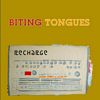 Recharge is the album that even time can't save. After foursongs appeared on a white label promo, the album, (the last recorded asBiting Tongues) recorded in 1989, was shelved. Technology can nevercompletely be substituted for humans, and I fairly certain that's whatI find problematic when muisicians start incorporating synths andmachines for the sake of replacing what was once live. The drum machineand synth sounds available to the now duo of Massey and Walmsley are sopainfully artificial, that it's best that they're not attempting torecreate the living drummer and horn sections. Simultaneously, theblueprints were outlined for 808 State, as the legendary QuadrastateEP was recorded at the same time in the same studio. Hints of 808classics like "Pacific" bleed through the poorly recorded firsttracks—I don't know if it's a remastering problem or if it was thestate of the original tapes, but the bass is completely overblown andmuddy on much of album. The squealy, cheesy guitar on "Take the BackRight Off" could even point to 808 State's mega hit "Cübik." Guestfemale vocals absolutely ruin the Biting Tongues'-ness of this releaseby the third track, "Love Out," while the novelty of the'ooh-we-just-got-a-sampler' in the form of endless female vocal sampleson "Increase" is simply painful. Only one track, "Neckwork," am I trulyenjoying thoroughly, but the slap-bass and white funk feel is morereminiscent of Code-era Cabaret Voltaire than anything BitingTongues did prior to 1989. Even this one track is honestly not worththe price or agony of the rest of the disc. Die hard 808 State fanswill probably find joy in this record, but Factory fans and those whofind an affinity for the earlier Biting Tongues material might want tohold off.
Recharge is the album that even time can't save. After foursongs appeared on a white label promo, the album, (the last recorded asBiting Tongues) recorded in 1989, was shelved. Technology can nevercompletely be substituted for humans, and I fairly certain that's whatI find problematic when muisicians start incorporating synths andmachines for the sake of replacing what was once live. The drum machineand synth sounds available to the now duo of Massey and Walmsley are sopainfully artificial, that it's best that they're not attempting torecreate the living drummer and horn sections. Simultaneously, theblueprints were outlined for 808 State, as the legendary QuadrastateEP was recorded at the same time in the same studio. Hints of 808classics like "Pacific" bleed through the poorly recorded firsttracks—I don't know if it's a remastering problem or if it was thestate of the original tapes, but the bass is completely overblown andmuddy on much of album. The squealy, cheesy guitar on "Take the BackRight Off" could even point to 808 State's mega hit "Cübik." Guestfemale vocals absolutely ruin the Biting Tongues'-ness of this releaseby the third track, "Love Out," while the novelty of the'ooh-we-just-got-a-sampler' in the form of endless female vocal sampleson "Increase" is simply painful. Only one track, "Neckwork," am I trulyenjoying thoroughly, but the slap-bass and white funk feel is morereminiscent of Code-era Cabaret Voltaire than anything BitingTongues did prior to 1989. Even this one track is honestly not worththe price or agony of the rest of the disc. Die hard 808 State fanswill probably find joy in this record, but Factory fans and those whofind an affinity for the earlier Biting Tongues material might want tohold off.
- Denture Beach (from After the Click)
- Compressor (from After the Click and Compressed)
- Double Gold St. Paul(from After the Click and Recharge)
Scott Morgan has accomplished nothing short of an evolution on his third CD, breathing new life into his own music and into the electronic genre in general. For the first time, Loscil is not built on machines and computers alone, but with the aid of live instrumentation overtop of the usual sequencing Morgan incorporates. The result is stunning, capable of inducing real dreamlike states with even a glancing listen. Where the last record was mainly music for and from the depths of the ocean, these songs are a bridge over the waters of the past, a gateway to rebirth and the promise of the future. Morgan provided a computer base for the musicians to improvise over, then took both segments and edited them for the final product, resulting in a half-organic, half-synthetic experience that just might be the best mix of the two I've ever heard. Drone elements still prevail, with Loscil's music being more about a mood or feeling than a structure. Rhodes piano, guitar and cello add new dimensions, grounding the experimental in something familiar that makes it easier to swallow. On tracks like "Lucy Dub," there is also a hope present as well as a feeling of life beginning or continuing on unhindered. Pan and fade effects evoke a Doppler-like reaction, where it feels like the music is actively swirling around and passing in and out of the ears with an ease and playfulness. All at once the elements of each track climax together, and create a gentle swaying effect that is exquisite; and though this might take a while as the tracks are all rather lengthy, there is never a dull or unstatisfying sustain, as each section of the song burgeons with individuality. This is the auditory equivalent of being in the womb for me, and after listening to it I always feel comfortable and warm. First Narrows represents a new Loscil, one that hopefully continue to grow in the same vein.
Samples can be found here.
 Susanna and the Magical Orchestra sway, saunter, and sulk through ninemelancholy originals and two spectacular cover versions on thisexceptional debut. List of Lights,...features production and additional instrumentation by Andreas Mjøs(Jaga Jazzist) and Deathprod, giving it a certain touch of music geekstreet cred. Rest assured, however, that this is a far more accessibleand poppy record than anything Rune Grammofon has released (to myknowledge), particularly due to the intimacy brought to the table byvocalist Susanna Karolina Wallumrød. Of course, her Nørwegian heritagenaturally compels American reviewers far lazier than I to drawcomparisons between her and that adored Scandinavian chanteuse Björk,easily encapsulating our opinions of the record into neat,reader-friendly boxes. However, it would be criminal to ignore or evengloss over Susanna's desperately fragile and foreign intonations, aswell as the endless waves of solemnity that define her standoutperformance style. Rejecting Björk's over-the-top delivery, Susannaopts to uses her time on record differently, exposing a strangelyseductive fragility instead of conjuring up some inner femininestrength. While singing simple yet powerful words like "happiness" and"joy," the sincerity in her voice expresses a general malaise and ayearning for deserved yet tragically inaccessible dreams, a sensestrategically supported by the truly "magical" compositions of primaryinstrumentalist Morten Qvenild. "Turn The Pages" overflows withdesperate strings and even more desperate questions, providing both themost straightforward vocal delivery on the album and the mostmemorable, albeit repetitious, chorus. In contrast, "Hello," one offive tracks with lyrics penned by Susanna, takes a more eclecticapproach musically and lyrically, featuring cryptic accusatory lines("Who are you to touch me in this very special way? / Who are you tostep on me in this very special way? / Hello at my doorstep.") andperhaps referencing a more disturbing context of victimization. Thecover versions, of Leonard Bernstein and Dolly Parton respectively, arejust as moving and powerful as the originals. The interpretation ofBernstein's "Who Am I" blends cold alien radio frequencies intoshimmering and bright keyboard tones without breaking any sense offlow, while the seemingly simplistic plucking on the highly emotional"Jolene" overflows with emotion as a result of its sparsity. Allthroughout, Qvenild constructs masterful beds of subtle sound, full ofspace and far more melodic and engaging than Matmos' work with theaforementioned Icelandic princess. With the Magical Orchestra, Qvenildhas discovered a comfortably tranquil niche in that delicate balancebetween conventional musicality and audio experimentation, and I canonly hope that he continues to collaborate with the enchanting Susannaon further releases. Without question, List of Lights and Buoys is one of the strongest contenders so far for placement atop my "Best Of" list for this year.
Susanna and the Magical Orchestra sway, saunter, and sulk through ninemelancholy originals and two spectacular cover versions on thisexceptional debut. List of Lights,...features production and additional instrumentation by Andreas Mjøs(Jaga Jazzist) and Deathprod, giving it a certain touch of music geekstreet cred. Rest assured, however, that this is a far more accessibleand poppy record than anything Rune Grammofon has released (to myknowledge), particularly due to the intimacy brought to the table byvocalist Susanna Karolina Wallumrød. Of course, her Nørwegian heritagenaturally compels American reviewers far lazier than I to drawcomparisons between her and that adored Scandinavian chanteuse Björk,easily encapsulating our opinions of the record into neat,reader-friendly boxes. However, it would be criminal to ignore or evengloss over Susanna's desperately fragile and foreign intonations, aswell as the endless waves of solemnity that define her standoutperformance style. Rejecting Björk's over-the-top delivery, Susannaopts to uses her time on record differently, exposing a strangelyseductive fragility instead of conjuring up some inner femininestrength. While singing simple yet powerful words like "happiness" and"joy," the sincerity in her voice expresses a general malaise and ayearning for deserved yet tragically inaccessible dreams, a sensestrategically supported by the truly "magical" compositions of primaryinstrumentalist Morten Qvenild. "Turn The Pages" overflows withdesperate strings and even more desperate questions, providing both themost straightforward vocal delivery on the album and the mostmemorable, albeit repetitious, chorus. In contrast, "Hello," one offive tracks with lyrics penned by Susanna, takes a more eclecticapproach musically and lyrically, featuring cryptic accusatory lines("Who are you to touch me in this very special way? / Who are you tostep on me in this very special way? / Hello at my doorstep.") andperhaps referencing a more disturbing context of victimization. Thecover versions, of Leonard Bernstein and Dolly Parton respectively, arejust as moving and powerful as the originals. The interpretation ofBernstein's "Who Am I" blends cold alien radio frequencies intoshimmering and bright keyboard tones without breaking any sense offlow, while the seemingly simplistic plucking on the highly emotional"Jolene" overflows with emotion as a result of its sparsity. Allthroughout, Qvenild constructs masterful beds of subtle sound, full ofspace and far more melodic and engaging than Matmos' work with theaforementioned Icelandic princess. With the Magical Orchestra, Qvenildhas discovered a comfortably tranquil niche in that delicate balancebetween conventional musicality and audio experimentation, and I canonly hope that he continues to collaborate with the enchanting Susannaon further releases. Without question, List of Lights and Buoys is one of the strongest contenders so far for placement atop my "Best Of" list for this year. The Legendary Pink Dots seem unaware or unconcerned about the unwrittenrecord industry rule that discourages artists from releasing multiplealbums simultaneously. The proverbial wisdom has it that multiplereleases confuse the record-buying public, and the albums tend tocannabilize each other's sales. Multiple albums have ruined a multitudeof bands, from the Incredible String Band all the way to Kiss and GunsN' Roses. Well, the Pink Dots have been ignoring that maxim for quite awhile now. In fact, Pink Dots albums tend to come it two and threes,often with a few solo albums thrown in for good measure. No exceptionhere, as this month brings three new Pink Dots releases, in addition toa new Ka-Spel solo album. Everything is being released on the eve oftheir North American tour, which takes them through far more US citiesthan any other underground British/Dutch post-industrial psychedelicart-goth group could even dream of visiting. The extensive touring maybe the secret to the Pink Dots impressive longevity and endurance, asthey are frequently one of the most critically ignored bands in theunderground scene. The Whispering Wallisn't going to rectify this situation, a typically indigestibleconcoction of psychedelic whimsy, wildly experimental textures, denselyprophetic lyrical themes and skewed songwriting all mixed up togetherin a gooey prog-rock quagmire. Evaluating its relative quality comparedto other albums is almost a moot point, as most hardcore Dots fans willcertainly want to own every album regardless, and others stopped caring30 albums ago. That said, The Whispering Wall does have some brilliant moments, and is very cohesive, easily eclipsing 2002's double feature of All The King's Horses and All The King's Men,albums that had strong points, but would have been better whittled downto a single disc. Those albums saw the band in a transitional period,finding their footing after the departure of Ryan Moore, trying out amore intimate, stripped-down sound that became tiresome after a fewlistens. This time around, there's been a few more personnel changes —the loss of guitarist/violinist Martijn de Kleer and the addition ofguitarist Erik Drost — but the Pink Dots have come out intact andsmelling (and sounding) like a bouquet of atomic roses. All thefamiliar Dots elements are present on The Whispering Wall.There's a good bit of future-scare dystopian proselytizing ("SoftToy"); a sinister riff on a nursery rhyme ("Dominic"); a slow-cookedinstrumental ("The Region Beyond"); the ubiquitous spoken-word EKSnarrative against a backdrop of densely layered noise and sound effects("The Divide"); and just plain demented silliness ("King of a SmallWorld"). The soupy production by Dots mainstay Raymond Steeg istypically heavy-handed (in a good way, lots of sonic detail), and eachplayer is given time to shine: Silverman's expertly-wieldedsynthesizers and rhythm programming, Niels Van Hoorn's exquisitesaxophone blasts and Erik Drost's gutsy swathes of shredding psychguitar are all variously highlighted in the mix. It's an accomplishedalbum by a prolific band who continue to prove that although less iscertainly more, more can also be more.
The Legendary Pink Dots seem unaware or unconcerned about the unwrittenrecord industry rule that discourages artists from releasing multiplealbums simultaneously. The proverbial wisdom has it that multiplereleases confuse the record-buying public, and the albums tend tocannabilize each other's sales. Multiple albums have ruined a multitudeof bands, from the Incredible String Band all the way to Kiss and GunsN' Roses. Well, the Pink Dots have been ignoring that maxim for quite awhile now. In fact, Pink Dots albums tend to come it two and threes,often with a few solo albums thrown in for good measure. No exceptionhere, as this month brings three new Pink Dots releases, in addition toa new Ka-Spel solo album. Everything is being released on the eve oftheir North American tour, which takes them through far more US citiesthan any other underground British/Dutch post-industrial psychedelicart-goth group could even dream of visiting. The extensive touring maybe the secret to the Pink Dots impressive longevity and endurance, asthey are frequently one of the most critically ignored bands in theunderground scene. The Whispering Wallisn't going to rectify this situation, a typically indigestibleconcoction of psychedelic whimsy, wildly experimental textures, denselyprophetic lyrical themes and skewed songwriting all mixed up togetherin a gooey prog-rock quagmire. Evaluating its relative quality comparedto other albums is almost a moot point, as most hardcore Dots fans willcertainly want to own every album regardless, and others stopped caring30 albums ago. That said, The Whispering Wall does have some brilliant moments, and is very cohesive, easily eclipsing 2002's double feature of All The King's Horses and All The King's Men,albums that had strong points, but would have been better whittled downto a single disc. Those albums saw the band in a transitional period,finding their footing after the departure of Ryan Moore, trying out amore intimate, stripped-down sound that became tiresome after a fewlistens. This time around, there's been a few more personnel changes —the loss of guitarist/violinist Martijn de Kleer and the addition ofguitarist Erik Drost — but the Pink Dots have come out intact andsmelling (and sounding) like a bouquet of atomic roses. All thefamiliar Dots elements are present on The Whispering Wall.There's a good bit of future-scare dystopian proselytizing ("SoftToy"); a sinister riff on a nursery rhyme ("Dominic"); a slow-cookedinstrumental ("The Region Beyond"); the ubiquitous spoken-word EKSnarrative against a backdrop of densely layered noise and sound effects("The Divide"); and just plain demented silliness ("King of a SmallWorld"). The soupy production by Dots mainstay Raymond Steeg istypically heavy-handed (in a good way, lots of sonic detail), and eachplayer is given time to shine: Silverman's expertly-wieldedsynthesizers and rhythm programming, Niels Van Hoorn's exquisitesaxophone blasts and Erik Drost's gutsy swathes of shredding psychguitar are all variously highlighted in the mix. It's an accomplishedalbum by a prolific band who continue to prove that although less iscertainly more, more can also be more. The Poppy Variations is the ill-natured twin of The Whispering Wall — the qlippothic, mirror-universe reflection, residing in the shadowy nightside of Eden. Where Whispering is right in line with LPD's current manifestation and evolution, Poppy is entirely regressive and even transgressive. Where Whispering is often joyful and musically rich, Poppyis spare, prickly and pessimistic. Rather than a series of inviting,accessible compositions, LPD creates a series of perverse spectralenigmas, even utilizing samples and reworkings of their older material,in some attempt at painstaking self-reflection and exegesis. EdwardKa-Spel's lyrics aren't as bemused and detached as usual here, instead,on many of the tracks, he sounds downright miserable, displaying thekind of perplexed mental fragmentation familiar from early Dotsmaterial like Asylum. Long sections of near-silence andpassages exhibiting the kind of wildly unorthodox experimentation notheard since the Steven Stapleton-produced Malachai: Shadow Weaver part 2make this album one of LPD's most difficult propositions in recentmemory. It's a schizophrenic experience attempting to place this albumin context with The Whispering Wall; best, then, to evaluate iton its own merits. Which are many, especially for diehard fans of earlyDots (read: freaks of nature) - the jagged, minimal electronics andKa-Spel's piercing graveyard whine, staccato drum machine rhythms,bizarre samples, loops and low-budget psychedelic touches thatcontribute to an air of drugged-out bedroom insanity. The hazy, summerbuzz of "Krussoe" shifts and festers in the background, as Ka-Spelmutters: "All I have is sand, a withered hand, a pile of cans, they'rerusting." More nautical metaphors (see Ka-Spel's Pieces of 8),this time the bedraggled literary castaway wishing for a ship to comeand take him away from his tropical hell. Even the song names on The Poppy Variationsseem to echo the album's dire outlook: "Personal Monster" and "ItDoesn't Matter Anway," a pair of songs that echo early Dots melodies,minimal treatments, up-close vocals explicating the most dreadfulfuturistic angst. "L'oiseau Rare (Pt. 1 & 2)" begins with wackyjungle-drums and bouncing vocals familiar from "Crumbs on the Carpet,"but it quickly segues into a lengthy excursion through enigmaticunfoldings of ambient meandering, lost in a vast interplanetary garbagescow at night. It's as frightening, haunted and lonely as The Tower or parts of Crushed Velvet Apocalypse.An Orson Welles-ish radio drama voice slips out of the aethyr on "TheHot Breath on Your Neck," creepily intoning:"It...is...later...than...you...think....," to which a resigned Ka-Spelreplies: "I know, you don't have to rub it in, do you?" Ouch. Thingsend on a note of spectacularly epic melancholy, with the two-part,25-minute picaresque musical patchwork of the title track, which usesthe classic track "Poppy Day" as a jumping off point for a lengthymeditation on depression and addiction. I've never felt so far awaylistening to music on my headphones, the track traveling through mentalcorridors, collecting faded memories and obsessed spirits, ultimatelyexploding into a massive and sinister soundscape of disembodied voices,radioactive swipes of brain-frying sound, cold metallic insectoidtextures and distant, reverberating funereal choruses of bagpipes. Inits own twisted, cadaverous way, The Poppy Variations is an even finer accomplishment than The Whispering Wall, a spooked missive from deep in the heart of the abyss.
The Poppy Variations is the ill-natured twin of The Whispering Wall — the qlippothic, mirror-universe reflection, residing in the shadowy nightside of Eden. Where Whispering is right in line with LPD's current manifestation and evolution, Poppy is entirely regressive and even transgressive. Where Whispering is often joyful and musically rich, Poppyis spare, prickly and pessimistic. Rather than a series of inviting,accessible compositions, LPD creates a series of perverse spectralenigmas, even utilizing samples and reworkings of their older material,in some attempt at painstaking self-reflection and exegesis. EdwardKa-Spel's lyrics aren't as bemused and detached as usual here, instead,on many of the tracks, he sounds downright miserable, displaying thekind of perplexed mental fragmentation familiar from early Dotsmaterial like Asylum. Long sections of near-silence andpassages exhibiting the kind of wildly unorthodox experimentation notheard since the Steven Stapleton-produced Malachai: Shadow Weaver part 2make this album one of LPD's most difficult propositions in recentmemory. It's a schizophrenic experience attempting to place this albumin context with The Whispering Wall; best, then, to evaluate iton its own merits. Which are many, especially for diehard fans of earlyDots (read: freaks of nature) - the jagged, minimal electronics andKa-Spel's piercing graveyard whine, staccato drum machine rhythms,bizarre samples, loops and low-budget psychedelic touches thatcontribute to an air of drugged-out bedroom insanity. The hazy, summerbuzz of "Krussoe" shifts and festers in the background, as Ka-Spelmutters: "All I have is sand, a withered hand, a pile of cans, they'rerusting." More nautical metaphors (see Ka-Spel's Pieces of 8),this time the bedraggled literary castaway wishing for a ship to comeand take him away from his tropical hell. Even the song names on The Poppy Variationsseem to echo the album's dire outlook: "Personal Monster" and "ItDoesn't Matter Anway," a pair of songs that echo early Dots melodies,minimal treatments, up-close vocals explicating the most dreadfulfuturistic angst. "L'oiseau Rare (Pt. 1 & 2)" begins with wackyjungle-drums and bouncing vocals familiar from "Crumbs on the Carpet,"but it quickly segues into a lengthy excursion through enigmaticunfoldings of ambient meandering, lost in a vast interplanetary garbagescow at night. It's as frightening, haunted and lonely as The Tower or parts of Crushed Velvet Apocalypse.An Orson Welles-ish radio drama voice slips out of the aethyr on "TheHot Breath on Your Neck," creepily intoning:"It...is...later...than...you...think....," to which a resigned Ka-Spelreplies: "I know, you don't have to rub it in, do you?" Ouch. Thingsend on a note of spectacularly epic melancholy, with the two-part,25-minute picaresque musical patchwork of the title track, which usesthe classic track "Poppy Day" as a jumping off point for a lengthymeditation on depression and addiction. I've never felt so far awaylistening to music on my headphones, the track traveling through mentalcorridors, collecting faded memories and obsessed spirits, ultimatelyexploding into a massive and sinister soundscape of disembodied voices,radioactive swipes of brain-frying sound, cold metallic insectoidtextures and distant, reverberating funereal choruses of bagpipes. Inits own twisted, cadaverous way, The Poppy Variations is an even finer accomplishment than The Whispering Wall, a spooked missive from deep in the heart of the abyss.samples:
 Pieces of 8 is the latest bookend to the long shelf filled with China Dolls too numerous to count, the holy books of Illumina, Lilith and Tanith, the Heartbreak, the Needles and the colors: Blue Room, Red Letters and Graye Skreeens. A vague continuation of the nautical, "soul set adrift at sea" themes explored on 2001's rambling, unfocused O'er a Shalabast'r Tyde Strolt Ay, the new album is — true to its title — an embarrassment of riches, a sunken treasure chest of pirate's booty. Pieces of 8is an amazingly well-crafted concept album of remarkable strength andfocus from an artist who would have every right to be well past hisartistic prime. Over the years, we've learned how to listen to EdwardKa-Spel's solo albums: the well-worn sonic palette, the familiararsenal of metaphors and lyrical themes. Ka-Spel's career as a soloartists is virtually predicated on its unfaltering uniformity,constantly retracing its own lines, deepening the grooves of an etchinglong since completed. Those who love Ka-Spel's music know to listen forthose tiny nuances, the changes in perspective, the recycling andre-contextualization of familiar lyrical conceits. Hence, there issomething of a learning curve for this music, an "EKS literacy" that isnurtured over time by repetitive exposure. What's amazing about Pieces of 8is that it may be Edward's first album that peeks its out of thatendlessly self-referential universe of bedroom electronics, crepuscularpsychedelia and microcosmic dread. Musically, it's one of the bestalbums EKS has ever crafted, consisting of several solid songwritingefforts balanced perfectly with evocative sound-effects suites andpassages of pure electronic ambience. Ka-Spel's trademark gallows humoris fully intact, explicating his constant themes of personal anduniversal apocalypse, and the existential dread experienced in a worldof human emotions increasingly mediated by technology. Opening with awhimsical sea-shanty that evokes some pre-war street accordionistplaying in a French harbor town, "The Writing on the Wall" inexplicablytransforms into a haunting piano dirge littered with atmosphericsamples. As ever, Edward is a storyteller, his lyrics spinning a yarnof a doomed man forced to walk the plank who, paradoxically, seemsendlessly amused by his fate. "Here Comes the Night" is a lengthy,sprawling ambient piece that follows the more abstract moments of Dark Side of the Moonto their logical conclusion: a majestic space-scape haunted by fragilepiano melodies and the ghostly transmissions of long-abandoneddeep-space probes. The blasted, distorted electro groove of "Comedown"is punctuated by handclaps and noisy throbs, Edward's spiralling vocalsevoking the terrors of infancy, pausing briefly to reference DavidLynch's Eraserhead. "Alms for Lepers" is more standard EKSfare: melancholic vocals filled with linguistic puns and odd metaphors,against a backdrop of spectral keyboards and deliberately syntheticdrum programming. The lengthy final track is a meticulouslyconstructed, multi-layered kosmische symphony of cyclical electronicpulses that build in hallucinogenic intensity before giving way to ascratchy, warbling old 78 spinning out fractured, kaleidescopicnostalgia which bobs out over the whitecaps and disappears from view.
Pieces of 8 is the latest bookend to the long shelf filled with China Dolls too numerous to count, the holy books of Illumina, Lilith and Tanith, the Heartbreak, the Needles and the colors: Blue Room, Red Letters and Graye Skreeens. A vague continuation of the nautical, "soul set adrift at sea" themes explored on 2001's rambling, unfocused O'er a Shalabast'r Tyde Strolt Ay, the new album is — true to its title — an embarrassment of riches, a sunken treasure chest of pirate's booty. Pieces of 8is an amazingly well-crafted concept album of remarkable strength andfocus from an artist who would have every right to be well past hisartistic prime. Over the years, we've learned how to listen to EdwardKa-Spel's solo albums: the well-worn sonic palette, the familiararsenal of metaphors and lyrical themes. Ka-Spel's career as a soloartists is virtually predicated on its unfaltering uniformity,constantly retracing its own lines, deepening the grooves of an etchinglong since completed. Those who love Ka-Spel's music know to listen forthose tiny nuances, the changes in perspective, the recycling andre-contextualization of familiar lyrical conceits. Hence, there issomething of a learning curve for this music, an "EKS literacy" that isnurtured over time by repetitive exposure. What's amazing about Pieces of 8is that it may be Edward's first album that peeks its out of thatendlessly self-referential universe of bedroom electronics, crepuscularpsychedelia and microcosmic dread. Musically, it's one of the bestalbums EKS has ever crafted, consisting of several solid songwritingefforts balanced perfectly with evocative sound-effects suites andpassages of pure electronic ambience. Ka-Spel's trademark gallows humoris fully intact, explicating his constant themes of personal anduniversal apocalypse, and the existential dread experienced in a worldof human emotions increasingly mediated by technology. Opening with awhimsical sea-shanty that evokes some pre-war street accordionistplaying in a French harbor town, "The Writing on the Wall" inexplicablytransforms into a haunting piano dirge littered with atmosphericsamples. As ever, Edward is a storyteller, his lyrics spinning a yarnof a doomed man forced to walk the plank who, paradoxically, seemsendlessly amused by his fate. "Here Comes the Night" is a lengthy,sprawling ambient piece that follows the more abstract moments of Dark Side of the Moonto their logical conclusion: a majestic space-scape haunted by fragilepiano melodies and the ghostly transmissions of long-abandoneddeep-space probes. The blasted, distorted electro groove of "Comedown"is punctuated by handclaps and noisy throbs, Edward's spiralling vocalsevoking the terrors of infancy, pausing briefly to reference DavidLynch's Eraserhead. "Alms for Lepers" is more standard EKSfare: melancholic vocals filled with linguistic puns and odd metaphors,against a backdrop of spectral keyboards and deliberately syntheticdrum programming. The lengthy final track is a meticulouslyconstructed, multi-layered kosmische symphony of cyclical electronicpulses that build in hallucinogenic intensity before giving way to ascratchy, warbling old 78 spinning out fractured, kaleidescopicnostalgia which bobs out over the whitecaps and disappears from view.samples:
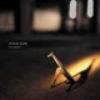 Whilerecording his second full-length, Kleine felt inspired to createseemingly with whatever he found lying about, and it has reinformed hismusic in a whole new light. The simple beauty of his other works ishere still, but augmented by a new dancefloor sensibility, and thestrength and assurance of years behind the boards and with aninstrument in hand. From the first song, "Home," the energy can befelt, as the album starts off with gentle keys and sounds beforeexploding into full boogie shuffle. The beats are never stale, soundinglike they were created from the ground up instead of from samples, andthe density of the sound is undeniable, with new sounds popping upevery time I listen; and that's just the first track. From there, it'son to the almost indie rock presence of "Stations," where the guitarand drums are joined by an otherworldly ringing and keyboards. Kleinecomplicates things more and more as the album progresses, getting moreand more creative with the rhythms and the tones he lays on top.Contrasting that is the all-out rock nature of songs like"Ghostwriting," that reinvigorate more than new rock bands could everhope to. Kleine took eighteen months to finish the record, and theeffort shows in the production, even though there is no real congruityto the songs as a whole. Maybe that's planned, or maybe that's just howit came out, but it's not a detractor: each song is a different storyor ghost and exists just fine on its own, lasting just as long or shortas it needs to. Real Ghosts is a tribute to Kleine's influencesand a reaction to the music of his past all at once, and as such it isthe boldest musical statement he's ever made.
Whilerecording his second full-length, Kleine felt inspired to createseemingly with whatever he found lying about, and it has reinformed hismusic in a whole new light. The simple beauty of his other works ishere still, but augmented by a new dancefloor sensibility, and thestrength and assurance of years behind the boards and with aninstrument in hand. From the first song, "Home," the energy can befelt, as the album starts off with gentle keys and sounds beforeexploding into full boogie shuffle. The beats are never stale, soundinglike they were created from the ground up instead of from samples, andthe density of the sound is undeniable, with new sounds popping upevery time I listen; and that's just the first track. From there, it'son to the almost indie rock presence of "Stations," where the guitarand drums are joined by an otherworldly ringing and keyboards. Kleinecomplicates things more and more as the album progresses, getting moreand more creative with the rhythms and the tones he lays on top.Contrasting that is the all-out rock nature of songs like"Ghostwriting," that reinvigorate more than new rock bands could everhope to. Kleine took eighteen months to finish the record, and theeffort shows in the production, even though there is no real congruityto the songs as a whole. Maybe that's planned, or maybe that's just howit came out, but it's not a detractor: each song is a different storyor ghost and exists just fine on its own, lasting just as long or shortas it needs to. Real Ghosts is a tribute to Kleine's influencesand a reaction to the music of his past all at once, and as such it isthe boldest musical statement he's ever made.samples:
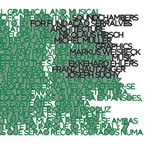 This is Staubgold's second architecturally-oriented release, the first being To Rococo Rot's Kolner Brett, a disc which set about creating a kind of audio simulation of Cologne's Kolner Brett building, situating tracks within a quasi-geometric framework and streamlining the group's austere sound into a series of registers meant to represent different parts of the biulding. Soundchambers is different, more of a commemoration or a traditional response piece than To Rococo's stylized production.
This is Staubgold's second architecturally-oriented release, the first being To Rococo Rot's Kolner Brett, a disc which set about creating a kind of audio simulation of Cologne's Kolner Brett building, situating tracks within a quasi-geometric framework and streamlining the group's austere sound into a series of registers meant to represent different parts of the biulding. Soundchambers is different, more of a commemoration or a traditional response piece than To Rococo's stylized production.
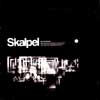 Ninja Tune has strayed away from the things that worked for it ahandful of years ago and as such, it hasn't been a label I've followedmuch since the heyday of Dj Vadim and Amon Tobin. Their new signing isa Polish act called Skalpel whose name conjures much more dire imagesthan their music, but works as a reference to the idea of surgicallycutting records together. Taking samples and bits from Polish jazzrecords and recombining them into new tracks, Skalpel do what so manyhave done before them, but with an amazing amount of precision andcare. The songs on their self-titled debut are mostly laid-back, mutedarrangements of horns and upright bass flowing effortlessly over funkydrums and the occassional hint of exotica. Polish Jazz records from the60's and 70's make up the bulk if not all of the source material,giving the album a steady, cohesive sound that rarely changes timbresenough to alert the listener that the record is made up of samples.Upon first listen, it all sounded a little too familiar as others likeKruder & Dorfmeister have travelled similar roads before. However,Skalpel bring a level of refined sophistication to the game that makesthe album something worth putting on again and again. Loops don't justrepeat here, they are changed and arranged organically so thateverything has the feel of a live band playing over some vinyl surfacenoise. The cheeky samples about dancing all night to jazz and playingPolish records are to be expected, but those are the only signs thatthis music is a conscious decendant of the jazz-record pillaging scene.The rest of the record plays as an homage to martinis and the dapperyoung people who drink them, and to the wonderful history of Polishjazz of which most people who hear this record will have noforeknowledge. While it's not a groundbreaking technical achievement,the production is seamless and ultra-smooth making this a perfectchill-out record or post-modern bachelor pad soundtrack. The disc alsoincludes three short films arranged to tracks on the album that helpround out the presentation. Their stark black and white imageryflickers and reminds me of hep cats in tuxedos and of the fondfalse-nostalgia for a bygone time that afflicts those of us who werenever alive to experience the things we see only in pre-color images.
Ninja Tune has strayed away from the things that worked for it ahandful of years ago and as such, it hasn't been a label I've followedmuch since the heyday of Dj Vadim and Amon Tobin. Their new signing isa Polish act called Skalpel whose name conjures much more dire imagesthan their music, but works as a reference to the idea of surgicallycutting records together. Taking samples and bits from Polish jazzrecords and recombining them into new tracks, Skalpel do what so manyhave done before them, but with an amazing amount of precision andcare. The songs on their self-titled debut are mostly laid-back, mutedarrangements of horns and upright bass flowing effortlessly over funkydrums and the occassional hint of exotica. Polish Jazz records from the60's and 70's make up the bulk if not all of the source material,giving the album a steady, cohesive sound that rarely changes timbresenough to alert the listener that the record is made up of samples.Upon first listen, it all sounded a little too familiar as others likeKruder & Dorfmeister have travelled similar roads before. However,Skalpel bring a level of refined sophistication to the game that makesthe album something worth putting on again and again. Loops don't justrepeat here, they are changed and arranged organically so thateverything has the feel of a live band playing over some vinyl surfacenoise. The cheeky samples about dancing all night to jazz and playingPolish records are to be expected, but those are the only signs thatthis music is a conscious decendant of the jazz-record pillaging scene.The rest of the record plays as an homage to martinis and the dapperyoung people who drink them, and to the wonderful history of Polishjazz of which most people who hear this record will have noforeknowledge. While it's not a groundbreaking technical achievement,the production is seamless and ultra-smooth making this a perfectchill-out record or post-modern bachelor pad soundtrack. The disc alsoincludes three short films arranged to tracks on the album that helpround out the presentation. Their stark black and white imageryflickers and reminds me of hep cats in tuxedos and of the fondfalse-nostalgia for a bygone time that afflicts those of us who werenever alive to experience the things we see only in pre-color images.samples:
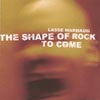 The press release calls it an assembled "history of extreme music,"covering death and black metals, free jazz, VU/Swans guitar walls, andthe power electronics spectrum. And while the cheeky title reiteratesMarhaug's impossible ambitions, it issafe to say that this disc represents one of the Norweigennoisemaster's most unrelenting works yet. As half of Jazzkammer and afrequent collaborator with noisemakers from across the globe, Marhaughas affixed his stamp of curdled feedback and precise digital doctoringto the range of experimental musics, from Jazzkammer's irreduciblepinprick landscapes to Maja Ratkje's operatic abstractions and on intothe dark densities of Merzbow and Kevin Drumm. The work of the lattertwo is where The Shape of Rock finds closest comparison.Consistent with his recent live shows, Marhaug explores the limits ofguitar feedback here, forcing shards of low-end click and hum throughrows of screeching effects and into the computer where things arereassembled into grainy staccato pulsings and writhing pools of sludge.Titles like "Sleeper" and "Magmadiver" point to the legacy of Norway'sblack metal scene; however, as far as audible similarity is concerned,other examples of electronic music paying homage to metal (like COH's Iron or any of Drumm's recent releases) come closer. For all of its excess, The Shape of Rockhangs onto a certain amount of the crisp, cool atmosphere thatcharacterizes much of the artist's work and begs to be associated withhis Nordic roots. Rather than peaking with dramatic transitions intorandom, deconstructive meltdown, the tracks climax with effectiveregroupings, organizing into thick laths of sound more likely toconjure images of looming, night-lit skyscrapers than Gothic ruins.Marhaug often exploits the digital foundation of each piece by guidingthe bulk of certain tracks into stuttering 'skip' patterns, a techniquethat works with the science fiction feel of the disc. Overall this is asolid addition to the catalog of one of Norway's most prolific andsuccessful noisemen; it is also one of his surprisingly few soloreleases, as good an entry point as any.
The press release calls it an assembled "history of extreme music,"covering death and black metals, free jazz, VU/Swans guitar walls, andthe power electronics spectrum. And while the cheeky title reiteratesMarhaug's impossible ambitions, it issafe to say that this disc represents one of the Norweigennoisemaster's most unrelenting works yet. As half of Jazzkammer and afrequent collaborator with noisemakers from across the globe, Marhaughas affixed his stamp of curdled feedback and precise digital doctoringto the range of experimental musics, from Jazzkammer's irreduciblepinprick landscapes to Maja Ratkje's operatic abstractions and on intothe dark densities of Merzbow and Kevin Drumm. The work of the lattertwo is where The Shape of Rock finds closest comparison.Consistent with his recent live shows, Marhaug explores the limits ofguitar feedback here, forcing shards of low-end click and hum throughrows of screeching effects and into the computer where things arereassembled into grainy staccato pulsings and writhing pools of sludge.Titles like "Sleeper" and "Magmadiver" point to the legacy of Norway'sblack metal scene; however, as far as audible similarity is concerned,other examples of electronic music paying homage to metal (like COH's Iron or any of Drumm's recent releases) come closer. For all of its excess, The Shape of Rockhangs onto a certain amount of the crisp, cool atmosphere thatcharacterizes much of the artist's work and begs to be associated withhis Nordic roots. Rather than peaking with dramatic transitions intorandom, deconstructive meltdown, the tracks climax with effectiveregroupings, organizing into thick laths of sound more likely toconjure images of looming, night-lit skyscrapers than Gothic ruins.Marhaug often exploits the digital foundation of each piece by guidingthe bulk of certain tracks into stuttering 'skip' patterns, a techniquethat works with the science fiction feel of the disc. Overall this is asolid addition to the catalog of one of Norway's most prolific andsuccessful noisemen; it is also one of his surprisingly few soloreleases, as good an entry point as any.samples:
 Piehead's third offering this year comes from the melodic electronicsolo act, Portland. Those familiar with the pioneering n5md label willprobably recognize the name, if not the sound of Portland, and that'slikely because Portland offers little to call his own on Uprox Detox. While the album charts a path through melancholic, beat-oriented IDM (a label used specifically to illicit memories of Artifical Intelligencecompilations and those who love them) with minor key synth tones andclicky, punchy drums, it ultimately plays as a tribute to those whohave gone before. Every moment of Uprox Detox is predictable,just as every sound coaxed out of the computer has been coaxed outbefore. Portland's pedigree lies firmly in the Warp/Skam family tree,and while this album is a worthwhile addition to a catalog of musicthat follows a certain set of rules, it never strays from those rules.These may not be preset drum and synth patches, but they might as wellbe, as most songs sound as though Portland has called up the "EarlyAutechre Kit" on some softsynth in order to compose. The songs arelikeable, genuinely nice in fact, but they aren't poised to startle orupset anyone, and that seems to be my biggest complaint. When thisstrain of IDM's progenitors took a staid techno formula and fucked withit to build something new, it was a little bit shocking, daring, andweird. Now, those same production tricks are nothing more than ashorthand for the kind of music that is characterized by blocky,condensed Helvetica typography and technologically-minded alternatespelling. Portland has rendered a polite and polished album here, butone that never quite cuts loose the way I wish it would. Uprox Detoxis a fine addition to a collection of otherwise ambiguous records, butI hope that next time he colors more outside of the lines.
Piehead's third offering this year comes from the melodic electronicsolo act, Portland. Those familiar with the pioneering n5md label willprobably recognize the name, if not the sound of Portland, and that'slikely because Portland offers little to call his own on Uprox Detox. While the album charts a path through melancholic, beat-oriented IDM (a label used specifically to illicit memories of Artifical Intelligencecompilations and those who love them) with minor key synth tones andclicky, punchy drums, it ultimately plays as a tribute to those whohave gone before. Every moment of Uprox Detox is predictable,just as every sound coaxed out of the computer has been coaxed outbefore. Portland's pedigree lies firmly in the Warp/Skam family tree,and while this album is a worthwhile addition to a catalog of musicthat follows a certain set of rules, it never strays from those rules.These may not be preset drum and synth patches, but they might as wellbe, as most songs sound as though Portland has called up the "EarlyAutechre Kit" on some softsynth in order to compose. The songs arelikeable, genuinely nice in fact, but they aren't poised to startle orupset anyone, and that seems to be my biggest complaint. When thisstrain of IDM's progenitors took a staid techno formula and fucked withit to build something new, it was a little bit shocking, daring, andweird. Now, those same production tricks are nothing more than ashorthand for the kind of music that is characterized by blocky,condensed Helvetica typography and technologically-minded alternatespelling. Portland has rendered a polite and polished album here, butone that never quite cuts loose the way I wish it would. Uprox Detoxis a fine addition to a collection of otherwise ambiguous records, butI hope that next time he colors more outside of the lines.samples:
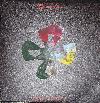 With the Drum MachineEP, the inimitable Peat Bog and the irrepressible Beta-Lactam RingRecords proffer three tracks and twenty-three additional minutes ofmolten mind expansion designed to sink even further into the murky,neo-primitive quagmire first experienced on Earthmonkey'sStapleton-produced debut. Only this time, Mr. Bog has upped the anteand reinvented himself, fully engaging the techno-Prog tendencies onlyglimpsed in his previous work. For better or worse (though certainlyfor the better), Drum Machine sounds like the overfed bastard offspring of The Orb's Adventure Beyond the Ultraworld and Coil's Love's Secret Domain being sexually molested by the Ozric Tentacles' Strangeitude. Where the debut had the stomping Neolithic beats and fuzzy riffage of some mid-70's Kraut-Prog castoff, Drum Machineunashamedly explores the connection between Kraan and The KLF; acid andecstasy; peyote visions and Bedouin trance. "Varana Swing" createsdense, subterranean tunnels connecting Ibiza to the darkest heartAfrica, full of cyclical tribalisms, layers of resonating synthesizersand queasy, dislocated sound effects that creep across the stereochannels. "Hanumantra," in addition to invoking the Be Here Nowimperatives of Baba Ram Dass, also sports a lovely zero-gravity guitarmelody that paints a backdrop for tranced-out group chanting and wavesof mutated cosmic debris. The track inhabits a similar post-Industrialspace-rock territory familiar from mid-to-late period Pink Dots. "BeThat Charge" is certainly the most unorthodox song that Earthmonkey hasyet devised: a whirling dervish of hardcore punk and Middle Easterndance music; The Stooges and a sect of Merkabian desert mystics meetingunder the Saharan moonlight for an all-nighter of hashish-addledslam-dancing. Although it references ethic musics, Earthmonkey's soundis unbounded by its location in spacetime, thrillinglyextra-geographical, suggestive of a world community of switched-onheads stretching from the parched American neo-tribal desert ofBurningman back to the musical primalisms of pre-Babylonian man.
With the Drum MachineEP, the inimitable Peat Bog and the irrepressible Beta-Lactam RingRecords proffer three tracks and twenty-three additional minutes ofmolten mind expansion designed to sink even further into the murky,neo-primitive quagmire first experienced on Earthmonkey'sStapleton-produced debut. Only this time, Mr. Bog has upped the anteand reinvented himself, fully engaging the techno-Prog tendencies onlyglimpsed in his previous work. For better or worse (though certainlyfor the better), Drum Machine sounds like the overfed bastard offspring of The Orb's Adventure Beyond the Ultraworld and Coil's Love's Secret Domain being sexually molested by the Ozric Tentacles' Strangeitude. Where the debut had the stomping Neolithic beats and fuzzy riffage of some mid-70's Kraut-Prog castoff, Drum Machineunashamedly explores the connection between Kraan and The KLF; acid andecstasy; peyote visions and Bedouin trance. "Varana Swing" createsdense, subterranean tunnels connecting Ibiza to the darkest heartAfrica, full of cyclical tribalisms, layers of resonating synthesizersand queasy, dislocated sound effects that creep across the stereochannels. "Hanumantra," in addition to invoking the Be Here Nowimperatives of Baba Ram Dass, also sports a lovely zero-gravity guitarmelody that paints a backdrop for tranced-out group chanting and wavesof mutated cosmic debris. The track inhabits a similar post-Industrialspace-rock territory familiar from mid-to-late period Pink Dots. "BeThat Charge" is certainly the most unorthodox song that Earthmonkey hasyet devised: a whirling dervish of hardcore punk and Middle Easterndance music; The Stooges and a sect of Merkabian desert mystics meetingunder the Saharan moonlight for an all-nighter of hashish-addledslam-dancing. Although it references ethic musics, Earthmonkey's soundis unbounded by its location in spacetime, thrillinglyextra-geographical, suggestive of a world community of switched-onheads stretching from the parched American neo-tribal desert ofBurningman back to the musical primalisms of pre-Babylonian man. 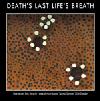 For the mere pittance of $4.00, Beta-Lactam Ring Records is offering the latest in its Beta-Beat Samplerseries. Where previous volumes were quick-and-dirty, minimally packagedreleases compiling and excerpting new and upcoming music on the label, Death's Last Life's Breathcomes in a printed sleeve, and includes a brand new Nurse With Woundtrack exclusive to this compilation. And it's no mere fragmentaryouttake meant to entice the unwary consumer, but an epic 15-minutefantasia of unhinged Stapletonian whimsy. "A Wasted Life of PhagocyteFoot Fetishism" plays like an extended, free-associating riff on theSpace Age Bachelor Pad music for which Stapleton has always professedhis affection. The track goes everywhere, of course, from a concerthall full of toy xylophones to sudden explosions of tabla rhythms,eventually floating up to a dense cloud bank of gently shimmeringkeyboards. If this were the only worthwhile track on Death's Last Life's Breath,it would still be more than worth the price of admission. Luckily, therest of the nearly 80-minute disc is chock full of the kind ofear-opening sonic exploration I've come to expect from the Beta-Lactamlabel, from the lysergic folk of Japan's Green Milk From the PlanetOrange to the eclectic, post-Prog collages of art-rock legends La STPO.Whitelodge's "Masters Within Spaces," excerpted from theirsoon-to-be-released debut, adds a level of post-rock sophistication tothe melancholic, apocalyptic themes explored by esoteric mainstaysCurrent 93 and Death in June. Judging by the distortion-blasted electrogroove of "Comedown," Edward Ka-Spel's new Pieces of 8 promisesto be his best in years. Matt Waldron's irr.app.(ext.) projectcontinues to find new non-corporeal identities in the labyrinthineinner workings of memory and synchronicity, on full display in a trulyunsettling excerpt from the forthcoming Perekluchenie album.Beequeen's "I'm Searching For Field Character" is a perfectlymysterious concoction of drones, dialogue samples and all manner ofindescribable textures. It came down to two choices this week: feed andclothe my Somalian sponsor kid for another month, or use my loosepocket change to buy Death's Last Life's Breath. Sorry about the lack of clean drinking water, N'Dugu, but I'll be happy to burn you a copy of this CD.
For the mere pittance of $4.00, Beta-Lactam Ring Records is offering the latest in its Beta-Beat Samplerseries. Where previous volumes were quick-and-dirty, minimally packagedreleases compiling and excerpting new and upcoming music on the label, Death's Last Life's Breathcomes in a printed sleeve, and includes a brand new Nurse With Woundtrack exclusive to this compilation. And it's no mere fragmentaryouttake meant to entice the unwary consumer, but an epic 15-minutefantasia of unhinged Stapletonian whimsy. "A Wasted Life of PhagocyteFoot Fetishism" plays like an extended, free-associating riff on theSpace Age Bachelor Pad music for which Stapleton has always professedhis affection. The track goes everywhere, of course, from a concerthall full of toy xylophones to sudden explosions of tabla rhythms,eventually floating up to a dense cloud bank of gently shimmeringkeyboards. If this were the only worthwhile track on Death's Last Life's Breath,it would still be more than worth the price of admission. Luckily, therest of the nearly 80-minute disc is chock full of the kind ofear-opening sonic exploration I've come to expect from the Beta-Lactamlabel, from the lysergic folk of Japan's Green Milk From the PlanetOrange to the eclectic, post-Prog collages of art-rock legends La STPO.Whitelodge's "Masters Within Spaces," excerpted from theirsoon-to-be-released debut, adds a level of post-rock sophistication tothe melancholic, apocalyptic themes explored by esoteric mainstaysCurrent 93 and Death in June. Judging by the distortion-blasted electrogroove of "Comedown," Edward Ka-Spel's new Pieces of 8 promisesto be his best in years. Matt Waldron's irr.app.(ext.) projectcontinues to find new non-corporeal identities in the labyrinthineinner workings of memory and synchronicity, on full display in a trulyunsettling excerpt from the forthcoming Perekluchenie album.Beequeen's "I'm Searching For Field Character" is a perfectlymysterious concoction of drones, dialogue samples and all manner ofindescribable textures. It came down to two choices this week: feed andclothe my Somalian sponsor kid for another month, or use my loosepocket change to buy Death's Last Life's Breath. Sorry about the lack of clean drinking water, N'Dugu, but I'll be happy to burn you a copy of this CD. There is no other, more clever way to say that this is by far the mostrefined Animal Collective recording to date. The album showcases astyle that Animal Collective have made all their own over the last fewrecordings: multitracked acoustic guitars, organic rhythms, primitivesound effects, sound samples, and atypical/moderately unpredictablelyrics. This time around, however, the band sound far more competentand confident in their skills as musicians, writers, and producers. Sung Tongsis both relaxed and playful from the beginning through the end. Itopens up with the chugging of "Leaf House," which ends with cat callsand continues on with "Who Could Win a Rabbit," both with a rich, fullsound and chugging with a cheery energy. "The Softest Voice" is thefirst song of the disc of sheer brilliance: drum-free with the layeringof gorgeous acoustic guitars and lush, pretty vocals. It's here whereit's strikingly apparent that the band have honed both their writingand production skills as everything subtly blends in with the morphingghostlike sounds through the middle and to the end. "Winters Love,"however, is probably most reminiscent of the earlier, more calmer"field" recordings, with a springy nostalgic guitar riff and loads ofunburied tape hiss for the first half, and the same riff repeated justcompletely re-interpreted and rearranged throughout the second half.While they sing of winter, for this and nearly all of the disc, I can'tshake the mental images of walking around in a pavement-free field witha blindingly bright sun while girls on bicycles ride by with longblonde hair blowing in slow motion. The epic 12+ minute "VisitingFriends" is like an abstract musical interpretation of the ocean asguitar chords are strummed in repetition, blended, and changed whilebeing multi-layered is similar to the tide coming in, washing over eachprevious wave. Animal Collective are undoubtedly influenced by popmusic, electronics, and psychedelic folk, but to me, their music isneither "folk" nor "free" nor Syd Barrett nor Beach Boys nor IncredibleString Band. It doesn't seem like their goal is to make tunes for thesole sake of easy digestion and widespread appeal, however, thankfullytheir appeal is wide enough to allow them to expand their audiences andevolve in the studio. Sung Tongs might be a little peculiar at first, but over repeated listens, it is creeping into my mental top for the year.
There is no other, more clever way to say that this is by far the mostrefined Animal Collective recording to date. The album showcases astyle that Animal Collective have made all their own over the last fewrecordings: multitracked acoustic guitars, organic rhythms, primitivesound effects, sound samples, and atypical/moderately unpredictablelyrics. This time around, however, the band sound far more competentand confident in their skills as musicians, writers, and producers. Sung Tongsis both relaxed and playful from the beginning through the end. Itopens up with the chugging of "Leaf House," which ends with cat callsand continues on with "Who Could Win a Rabbit," both with a rich, fullsound and chugging with a cheery energy. "The Softest Voice" is thefirst song of the disc of sheer brilliance: drum-free with the layeringof gorgeous acoustic guitars and lush, pretty vocals. It's here whereit's strikingly apparent that the band have honed both their writingand production skills as everything subtly blends in with the morphingghostlike sounds through the middle and to the end. "Winters Love,"however, is probably most reminiscent of the earlier, more calmer"field" recordings, with a springy nostalgic guitar riff and loads ofunburied tape hiss for the first half, and the same riff repeated justcompletely re-interpreted and rearranged throughout the second half.While they sing of winter, for this and nearly all of the disc, I can'tshake the mental images of walking around in a pavement-free field witha blindingly bright sun while girls on bicycles ride by with longblonde hair blowing in slow motion. The epic 12+ minute "VisitingFriends" is like an abstract musical interpretation of the ocean asguitar chords are strummed in repetition, blended, and changed whilebeing multi-layered is similar to the tide coming in, washing over eachprevious wave. Animal Collective are undoubtedly influenced by popmusic, electronics, and psychedelic folk, but to me, their music isneither "folk" nor "free" nor Syd Barrett nor Beach Boys nor IncredibleString Band. It doesn't seem like their goal is to make tunes for thesole sake of easy digestion and widespread appeal, however, thankfullytheir appeal is wide enough to allow them to expand their audiences andevolve in the studio. Sung Tongs might be a little peculiar at first, but over repeated listens, it is creeping into my mental top for the year.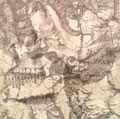 When Piano Magic starts singing about libraries, things are right in the universe once again. By a similar axiom, a good Piano Magic album is marked by its invocation of libraries in one or more songs. Thus, the "The Tollbooth Martrys," the seventh song on The Troubled Sleep Of Piano Magic, is evidence that Magic has produced another splendidly ethereal album. This wasn't the case with the previous album, Writers Without Homes, which was noticeably devoid of libraries.
When Piano Magic starts singing about libraries, things are right in the universe once again. By a similar axiom, a good Piano Magic album is marked by its invocation of libraries in one or more songs. Thus, the "The Tollbooth Martrys," the seventh song on The Troubled Sleep Of Piano Magic, is evidence that Magic has produced another splendidly ethereal album. This wasn't the case with the previous album, Writers Without Homes, which was noticeably devoid of libraries.
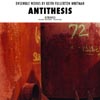 If Playthroughs was a meditation on the blurred landscapes of sleep, Antithesiscomes as a particularization: a focus on the sounds happeningin-between. Things are evidently different the moment "Twin GuitarRhodes Viola Drone (for LaMonte Young)" begins. Though steeped in themystique and subtle caress of electric moans, "Twin Guitar Rhodes..."is blessed with the pure and unaltered sound of piano melodies, choralecho, and unmistakable guitar rhythms. It's incorrect to say that KeithFullerton Whitman's sound is evolving, all of these tracks wererecorded between 1994 and 2002. Whitman is showing us another sidethough: "Obelisk (for Kurt Schwitters)" plays through a labyrinth ofeerie howls, altered vibrations, and percussive rattles. The shaking ofmetal and the rolling of low drums establishes a whole new world ofsounds I've not heard from Whitman before and it sounds fantastic.While the first two tracks had me excited, it's side B that sounds mostawe-inspiring. "Rhodes Viola Multiple" begins with an oddly phrasedmelody that tiptoes over the rest of the song; it produces the image inmy mind of a small girl dancing in the summer. The background is filledwith sound of spaceships launching into space and cars buzzing by underthe sun - the music begins to hum as a unified whole eventually and thesound drifts off into a haze of bird calls and interdimensional timewarps. "Schnee" comes as the biggest and most welcome surprise. Thetrack begins with the melodic plucking of a guitar underscored by thetribal rhythm of tomtom drums and heavy cymbals. Slowly the buzz andform of an electric guitar climbs over the mass of rhythm and ushersforth smoke and shadowy figures, feeling like, at times, the soul of asnake-charmer. The electric and acoustic guitar struggle with eachother, each establishing a new melody over the last, and all the whiledrum solos trace out the pulse of the struggle. Everything about thisEP is gorgeous. The music is a an excellent treat from Whitman - thesongs reveal a side of his compositional skills I've never heard beforeand they're nothing short of magical.
If Playthroughs was a meditation on the blurred landscapes of sleep, Antithesiscomes as a particularization: a focus on the sounds happeningin-between. Things are evidently different the moment "Twin GuitarRhodes Viola Drone (for LaMonte Young)" begins. Though steeped in themystique and subtle caress of electric moans, "Twin Guitar Rhodes..."is blessed with the pure and unaltered sound of piano melodies, choralecho, and unmistakable guitar rhythms. It's incorrect to say that KeithFullerton Whitman's sound is evolving, all of these tracks wererecorded between 1994 and 2002. Whitman is showing us another sidethough: "Obelisk (for Kurt Schwitters)" plays through a labyrinth ofeerie howls, altered vibrations, and percussive rattles. The shaking ofmetal and the rolling of low drums establishes a whole new world ofsounds I've not heard from Whitman before and it sounds fantastic.While the first two tracks had me excited, it's side B that sounds mostawe-inspiring. "Rhodes Viola Multiple" begins with an oddly phrasedmelody that tiptoes over the rest of the song; it produces the image inmy mind of a small girl dancing in the summer. The background is filledwith sound of spaceships launching into space and cars buzzing by underthe sun - the music begins to hum as a unified whole eventually and thesound drifts off into a haze of bird calls and interdimensional timewarps. "Schnee" comes as the biggest and most welcome surprise. Thetrack begins with the melodic plucking of a guitar underscored by thetribal rhythm of tomtom drums and heavy cymbals. Slowly the buzz andform of an electric guitar climbs over the mass of rhythm and ushersforth smoke and shadowy figures, feeling like, at times, the soul of asnake-charmer. The electric and acoustic guitar struggle with eachother, each establishing a new melody over the last, and all the whiledrum solos trace out the pulse of the struggle. Everything about thisEP is gorgeous. The music is a an excellent treat from Whitman - thesongs reveal a side of his compositional skills I've never heard beforeand they're nothing short of magical. 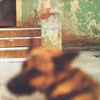 Following the Finnish-born duo's most intense live journey, the groupreleases their most ambitious recording to date. In the three yearssince Aaltopiiri,live opportunities have taken them to the most remote corners of theworld including Europe, Spain, the Americas and Easter Island, this isall following that now famous ad in The Wire magazine asking people in interesting places to put them up and pay them a small amount. Kestois four CDs of all new material, recorded over the last year in Berlin,but with sources and inspiriations from the group's extensive travels.Pan Sonic fans know that while the group's instrumentation remainssomewhat constant, their styles bounce back and forth betweenear-bleeding beats to quiet drones or heady field recordings. Unlike onAaltopiiri, where everything was sort of all mixed in together, on Kesto,things are separated. The first two discs are the fucking sexiestthings I've heard all year: pounding with an unparallelled abrasivebeauty, the beats that mark many of their most receptive live rock 'nroll (or at least as close as Pan Sonic can come to rock) performances.On these discs are 140 minutes of vicious assaults and trademark PanSonic sounds, where the group even pays homage to a number of theirinfluences like Bruce Gilbert, Keiji Haino, Suicide, and ThrobbingGristle, mimicking sounds they've done in almost reinterpretive pieces.Disc three begins the quiet half of the set, with songs that arefrequently filled with the unfilling sounds of silence. It opens with atoilet bowl flush and continues for the rest of the tracks mostly fromprocessed sounds of non-musical sources. While discs one and two areperfect blasting music for a night on the town, disc three isdefinitely something that is best at home, as the silences in oddenvironments trigger the "is this thing still playing?" reaction overand over again. The set ends with the CD-long track "Säteily,"(translation: "Radiation") which is a chilly 61:16 minute drone. Itwould easily make any fan of Time Machines purr like a kitten.It's perfect for lulling any beast (party animal or other) to sleepafter a multi-disc set which could be best described as an endurancetest! While this is undoubtedly the best multi-disc set of new materialreleased by anybody this year, I do have one minor issue with theflimsy packaging, which came unglued only on the second day, so bewarned on that account, but don't be afraid of the aural treasuresinside.
Following the Finnish-born duo's most intense live journey, the groupreleases their most ambitious recording to date. In the three yearssince Aaltopiiri,live opportunities have taken them to the most remote corners of theworld including Europe, Spain, the Americas and Easter Island, this isall following that now famous ad in The Wire magazine asking people in interesting places to put them up and pay them a small amount. Kestois four CDs of all new material, recorded over the last year in Berlin,but with sources and inspiriations from the group's extensive travels.Pan Sonic fans know that while the group's instrumentation remainssomewhat constant, their styles bounce back and forth betweenear-bleeding beats to quiet drones or heady field recordings. Unlike onAaltopiiri, where everything was sort of all mixed in together, on Kesto,things are separated. The first two discs are the fucking sexiestthings I've heard all year: pounding with an unparallelled abrasivebeauty, the beats that mark many of their most receptive live rock 'nroll (or at least as close as Pan Sonic can come to rock) performances.On these discs are 140 minutes of vicious assaults and trademark PanSonic sounds, where the group even pays homage to a number of theirinfluences like Bruce Gilbert, Keiji Haino, Suicide, and ThrobbingGristle, mimicking sounds they've done in almost reinterpretive pieces.Disc three begins the quiet half of the set, with songs that arefrequently filled with the unfilling sounds of silence. It opens with atoilet bowl flush and continues for the rest of the tracks mostly fromprocessed sounds of non-musical sources. While discs one and two areperfect blasting music for a night on the town, disc three isdefinitely something that is best at home, as the silences in oddenvironments trigger the "is this thing still playing?" reaction overand over again. The set ends with the CD-long track "Säteily,"(translation: "Radiation") which is a chilly 61:16 minute drone. Itwould easily make any fan of Time Machines purr like a kitten.It's perfect for lulling any beast (party animal or other) to sleepafter a multi-disc set which could be best described as an endurancetest! While this is undoubtedly the best multi-disc set of new materialreleased by anybody this year, I do have one minor issue with theflimsy packaging, which came unglued only on the second day, so bewarned on that account, but don't be afraid of the aural treasuresinside.- Pakoisvoima (transl: Fugalforce) - from CD 1
- Ilma (transl: Air) - from CD 4
- Säteily (transl: Radiation) - from CD 4
 Though Steven Stapleton is inevitably characterized as a something of a"lone wolf" — a vaguely psychotic outsider, compulsively andprolifically pumping out mysterious and inscrutable musical esotericafrom some dilapidated shack deep in the Irish countryside — he has, infact, remained a thoroughly collaborative artist throughout his longcareer. It took 1999's compilation The Swinging Reflective: Favourite Moments of Mutual Ecstasyto finally demonstrate the impressive array of artists that Stapletonhas worked with over the years: from contemporaries like Foetus, TonyWakeford and The Legendary Pink Dots to artists like Stereolab, who aresituated well outside of NWW's post-industrial milieu. It is this sameintensely collaborative spirit that manifests on Angry Eelectric Finger (Spitch'Cock One),a newly-issued prologue to an upcoming triple-album set featuringcollaborations with Cyclobe, irr.app.(ext.), Jim O'Rourke and XholCaravan. These were long-distance reciprocations, with Stapletonsending raw materials to each of the artists, who were free torecontextualize and mutate the sounds as they saw fit. These longformremixes were sent back to Stapleton, who added some finishingproduction touches and let them stand. This unique process has yieldeda series of tracks in which the personalities of Stapleton's musicalaccomplices come through very strongly, even as they each reverentlypay homage to the work of Nurse With Wound. The disc opens with a piececredited only to NWW, a classic 11-minute brain-twister that utilizesbending, distorted bass guitar strings to disorienting effect. Eachmetallic pluck swoops and dithers around a senseless insectoid rhythm,the piece eventually expanding into a blasted Cold War furnace factorydominated by an ancient, wheezing iron lung. Erudite Nurse-o-phileswill recognize these sounds from An Akward Pause and the Current 93 collaboration Bright Yellow Moon,Stapleton clearly enforcing the "recycled sound" aesthetic from theoutset. Next up is Cyclobe's "Paraparaparallelogrammatica," certainlythe most gorgeous track on the album, a stately science-fiction mindexcursion of the kind that dominated Simon and Stephen's immeasurablywonderful The Visitors. It's a texturally rich space fanfare ofthe kind not heard since Atem-era Tangerine Dream, and perhaps not eventhen. Its indulgent cinematic sensuality bears little similarity toStapleton's cod surrealism, save for the narrative unfolding andnuanced, lysergic vibrations that dominate the track. It's one of thebest things I've heard from Cyclobe, and regardless of whether or notit bears any resemblance to the original NWW source material, I'mcertain that this would have appeared on the infamous NWW InfluenceList had it been released on some obscure German prog label in theearly 1970s. Matt Waldron's irr.app.(ext.) project has been responsiblefor some of the most intensely rendered audio phenomena outside of theNWW camp, and their match-up — tellingly entitled "Mute Bell ExtinctionProcess" — again reflects primarily the interests of the remixer,rather than the remixed. While eerily recalling such creepy NWWclassics as "Fashioned to a Device Behind a Tree," irr.app.(ext.) onceagain shows a unique talent for thought cancellation, creating aninsistently clandestine, industrial trance-scape that uses repetitionto progressively wipe clean all thoughts and prepare the listener forthe loss of physical cohesion. The last track is Jim O'Rourke's "TapeMonkey Mooch," a laptop-concrete take on the history and mystery ofNurse With Wound. In its own unique way, O'Rourke's contribution isprobably the oddest on this record. Strange to think this was createdby a current member of art-punk darlings Sonic Youth and the creator ofan endless barrage of John Fahey-influenced indie-pop; not so strange,however, to anyone who has ever witnessed one of O'Rourke's freeformlaptop collage performances, which often reference the 80'spost-industrial tape-music underground of Roger Doyle and HNAS.O'Rourke sound collage creates an abstract web of richly-detailedsounds, compounding details that give way to form and structure, whichmelt into abstraction and back into structure. It's a gloriouslybaffling riddle, and if its quality is at all indicative of thematerial on the forthcoming three-album set, I can hardly wait.
Though Steven Stapleton is inevitably characterized as a something of a"lone wolf" — a vaguely psychotic outsider, compulsively andprolifically pumping out mysterious and inscrutable musical esotericafrom some dilapidated shack deep in the Irish countryside — he has, infact, remained a thoroughly collaborative artist throughout his longcareer. It took 1999's compilation The Swinging Reflective: Favourite Moments of Mutual Ecstasyto finally demonstrate the impressive array of artists that Stapletonhas worked with over the years: from contemporaries like Foetus, TonyWakeford and The Legendary Pink Dots to artists like Stereolab, who aresituated well outside of NWW's post-industrial milieu. It is this sameintensely collaborative spirit that manifests on Angry Eelectric Finger (Spitch'Cock One),a newly-issued prologue to an upcoming triple-album set featuringcollaborations with Cyclobe, irr.app.(ext.), Jim O'Rourke and XholCaravan. These were long-distance reciprocations, with Stapletonsending raw materials to each of the artists, who were free torecontextualize and mutate the sounds as they saw fit. These longformremixes were sent back to Stapleton, who added some finishingproduction touches and let them stand. This unique process has yieldeda series of tracks in which the personalities of Stapleton's musicalaccomplices come through very strongly, even as they each reverentlypay homage to the work of Nurse With Wound. The disc opens with a piececredited only to NWW, a classic 11-minute brain-twister that utilizesbending, distorted bass guitar strings to disorienting effect. Eachmetallic pluck swoops and dithers around a senseless insectoid rhythm,the piece eventually expanding into a blasted Cold War furnace factorydominated by an ancient, wheezing iron lung. Erudite Nurse-o-phileswill recognize these sounds from An Akward Pause and the Current 93 collaboration Bright Yellow Moon,Stapleton clearly enforcing the "recycled sound" aesthetic from theoutset. Next up is Cyclobe's "Paraparaparallelogrammatica," certainlythe most gorgeous track on the album, a stately science-fiction mindexcursion of the kind that dominated Simon and Stephen's immeasurablywonderful The Visitors. It's a texturally rich space fanfare ofthe kind not heard since Atem-era Tangerine Dream, and perhaps not eventhen. Its indulgent cinematic sensuality bears little similarity toStapleton's cod surrealism, save for the narrative unfolding andnuanced, lysergic vibrations that dominate the track. It's one of thebest things I've heard from Cyclobe, and regardless of whether or notit bears any resemblance to the original NWW source material, I'mcertain that this would have appeared on the infamous NWW InfluenceList had it been released on some obscure German prog label in theearly 1970s. Matt Waldron's irr.app.(ext.) project has been responsiblefor some of the most intensely rendered audio phenomena outside of theNWW camp, and their match-up — tellingly entitled "Mute Bell ExtinctionProcess" — again reflects primarily the interests of the remixer,rather than the remixed. While eerily recalling such creepy NWWclassics as "Fashioned to a Device Behind a Tree," irr.app.(ext.) onceagain shows a unique talent for thought cancellation, creating aninsistently clandestine, industrial trance-scape that uses repetitionto progressively wipe clean all thoughts and prepare the listener forthe loss of physical cohesion. The last track is Jim O'Rourke's "TapeMonkey Mooch," a laptop-concrete take on the history and mystery ofNurse With Wound. In its own unique way, O'Rourke's contribution isprobably the oddest on this record. Strange to think this was createdby a current member of art-punk darlings Sonic Youth and the creator ofan endless barrage of John Fahey-influenced indie-pop; not so strange,however, to anyone who has ever witnessed one of O'Rourke's freeformlaptop collage performances, which often reference the 80'spost-industrial tape-music underground of Roger Doyle and HNAS.O'Rourke sound collage creates an abstract web of richly-detailedsounds, compounding details that give way to form and structure, whichmelt into abstraction and back into structure. It's a gloriouslybaffling riddle, and if its quality is at all indicative of thematerial on the forthcoming three-album set, I can hardly wait.samples:
- Cyclobe/NWW - > Paraparaparallelogrammatica
- irr.app.(ext.)/NWW - Mute Bell Extinction Process
- Jim O'Rourke/NWW - Tape Monkey Mooch



